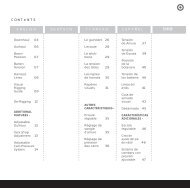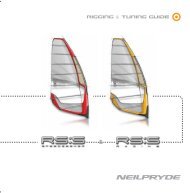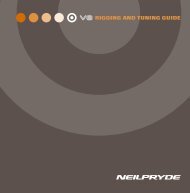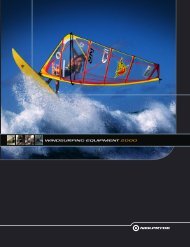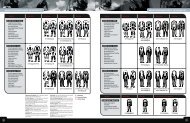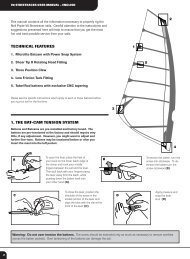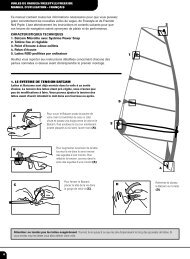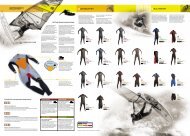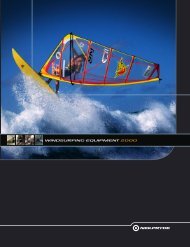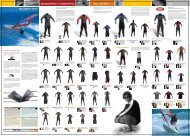Raf Supernova - Neil Pryde
Raf Supernova - Neil Pryde
Raf Supernova - Neil Pryde
You also want an ePaper? Increase the reach of your titles
YUMPU automatically turns print PDFs into web optimized ePapers that Google loves.
RAF SUPERNOVA USER MANUAL - ENGLISH<br />
This manual contains all the information necessary to properly rig the <strong>Neil</strong><br />
<strong>Pryde</strong> RAF <strong>Supernova</strong> sails. Careful attention to the instructions and<br />
suggestions presented here will help to ensure that you get the most fun and<br />
best possible service from your sails.<br />
TECHNICAL FEATURES<br />
1. Batcam III with Power Snap System<br />
2. Head Extension Fitting For Longer Masts<br />
3. Two position clew<br />
4. Low Friction Tack Fitting<br />
5. Rod battens with exclusive CNC tapering<br />
Please see the specific instructions which apply to each of these features<br />
before you rig your sail for the first time.<br />
1<br />
2<br />
1. THE BAT-CAM TENSION SYSTEM<br />
Battens and Batcams are pre-installed and factory tuned. The<br />
battens are pre-tensioned at the factory and should require very<br />
little, if any adjustment. However, you might want to adjust and<br />
further fine-tune. Battens may be tensioned before or after you<br />
insert the mast into the luff pocket.<br />
5<br />
A<br />
To open the lever, place the heel of your<br />
hand on the lower leech edge of the clamp<br />
and hook your middle fingers between the<br />
sail and the lever. Then pull back with your<br />
fingers prying the lever away from the leech,<br />
while pushing down the batten itself with<br />
your other hand (A).<br />
3<br />
B<br />
To tension the batten, turn the screw<br />
anti-clockwise. To de-tension the<br />
batten turn the screw clockwise (B).<br />
4<br />
C<br />
To close the lever, position<br />
the shoulder of the screw in<br />
the socket portion of the<br />
lever and align the tube with<br />
the clip at the front of the<br />
lever (C).<br />
D<br />
Apply pressure and<br />
snap the lever shut<br />
(D).<br />
Warning: Do not over tension the battens. The screw should be extended only as much as necessary to remove wrinkles across the batten<br />
pockets. Over tensioning of the battens can damage the sail.<br />
2
RAF SUPERNOVA USER MANUAL - ENGLISH<br />
2. HEAD FITTING When used with the recommended mast, the<br />
<strong>Neil</strong> <strong>Pryde</strong> fixed length head fitting offers a very clean and aerodynamic<br />
profile, with no unnecessary and heavy webbing flying around. By<br />
following the printed specifications at the tack of the sail, you will obtain<br />
the best tuning for your sail. However, in some cases (different length<br />
mast or different extension system), you may need to use the adjustable<br />
strap that is supplied with your sail (in the pocket of the sail bag).<br />
Remove the male plug (A) from the webbing (B) that is sewn into the<br />
luff pocket. Take the adjustable strap (C) and loop it through the<br />
webbing (B) and the male plug (A), and position the buckle behind<br />
the mast. Adjust to desired length.<br />
2<br />
A<br />
B<br />
C<br />
3<br />
3. TWO POSITION CLEW Select the clew<br />
ring that’s best suited to your requirements. Most<br />
riders like the boom to be roughly perpendicular to<br />
the mast, so start by setting the clew according to<br />
your preferred boom height. Many riders prefer a<br />
higher clew position in onshore conditions where<br />
putting the rig forward helps in staying up wind as<br />
well as in making backside maneuvers easier. Try a<br />
lower clew ring in side shore, down-the-line conditions<br />
for a softer leech and a more powerful<br />
bottom turn.<br />
4<br />
A<br />
D<br />
B<br />
C<br />
4. LOW FRICTION TACK<br />
FITTING The Low Friction Tack Fitting<br />
must be rigged properly to ensure<br />
optimum downhauling efficiency. Always<br />
rig the tack fitting according to the<br />
diagram.<br />
CHOOSING THE RIGHT MAST<br />
Every <strong>Neil</strong> <strong>Pryde</strong> sail is designed around a specific<br />
recommended mast. To get the optimum performance from<br />
your <strong>Neil</strong> <strong>Pryde</strong> sails, use the recommended mast. In many<br />
cases an alternative mast is specified and this will also<br />
provide good performance. For a lighter and more responsive<br />
feel, you can choose to use the upgrade masts which are<br />
specified.<br />
A NOTE ON RIG DIMENSIONS<br />
The rig dimensions printed on the tack of all <strong>Neil</strong> <strong>Pryde</strong><br />
collection sails show the following information:<br />
■ Base setting This is the number at which you should set<br />
the ring on your <strong>Neil</strong> <strong>Pryde</strong> aluminum or carbon mast base.<br />
Rigged on the correct mast and with a <strong>Neil</strong> <strong>Pryde</strong> mast base,<br />
you will be able to perfectly downhaul your sail by following<br />
the printed instructions at the tack of the sail.<br />
■ Boom dimensions are stated at the best average tuned<br />
dimensions plus or minus 1 cm. This is measured from the<br />
forward edge of the mast (at the center of the boom cut out)<br />
to the sail clew between the eyelets.<br />
These figures are intended as a guide to proper sail trim and,<br />
depending on the rig components you use, may not always<br />
correspond perfectly to the settings which are the best for you.<br />
RIGGING<br />
A. Set your boom and mast base to the dimensions printed near the<br />
tack. The sail is designed to be perfectly trimmed on the correct mast at<br />
the recommended settings. For sails with adjustable head fittings, set<br />
the webbing to the specified dimensions.<br />
B. Check that all the battens are fully inserted into their pockets. The<br />
battens are pre-tensioned at the factory and should require very little, if<br />
any adjustment.<br />
C. Insert the mast into the luff pocket working the sail down the mast a<br />
bit at a time. When you have the mast almost all the way in, use the<br />
tack handle to help pull the remaining distance to the mast base.<br />
D. Thread the downhaul line according to the instructions and partially<br />
tension the luff using the low friction tack fitting.<br />
E. Attach the boom to the mast,<br />
allowing space above it in the<br />
cut-out so that the sail can be<br />
fully downhauled later.<br />
F. Downhaul the sail to<br />
approximately 1 cm above the<br />
cleat base as shown in diagram.<br />
Fine-tune around this position. A<br />
small sticker has been provided<br />
with your sail which you can<br />
wrap around your mast base and<br />
use as a reference when you find<br />
your best tuning. All 1998 <strong>Neil</strong><br />
<strong>Pryde</strong> mast bases already carry this trim zone. When in the correct<br />
tuning range, the tack pulley will be as shown.<br />
G. If necessary, re-tension the battens until wrinkles at the batten<br />
pockets disappear. Be sure not to over-tension the battens.<br />
H. Adjust the outhaul to the recommended dimensions and make the<br />
boom length so the clew is within two centimeters of the boom end.<br />
Use a tape measure to ensure accuracy and repeatability of the<br />
settings.<br />
I. To ensure correct tuning for your specific sail, please consult the trim<br />
instructions that follow:<br />
RIGGING TIPS<br />
Pure RAF sails have no cams, so putting the mast into the luff pocket is<br />
easy. Grab the sail by using the handle located inside the fairing. Our<br />
MPR model has one intercam, but putting the mast into the luffpocket<br />
is almost as easy as on RAF sails. Just make sure that the Intercam is<br />
properly seated on the mast.<br />
DE-RIGGING<br />
A. Be sure that the tack fairing is clear of the mast base rings and<br />
other rig components.<br />
B. Carefully ease the outhaul until it is completely loose.<br />
Remove the boom.<br />
C. Carefully release the downhaul a little at a time. Remove the mast.<br />
3
RAF SUPERNOVA USER MANUAL - ENGLISH<br />
TUNING RAF SUPERNOVA SAILS<br />
When correctly rigged on the beach, the <strong>Neil</strong> <strong>Pryde</strong> RAF <strong>Supernova</strong><br />
sails will show little looseness in the upper leech. Modern sails require<br />
firm (although properly twisted) foil forms and positive outhaul tension.<br />
It is a mistake to try to tune today’s sails with extremely loose leeches<br />
from extreme downhaul, and negative outhaul.<br />
First set the mast base to the setting printed at the sail tack. Then<br />
follow the steps below to correctly fine tune your sail. Use a tape<br />
measure to check and record your favorite trim settings.<br />
Downhaul: until the tack pulley is within the prescribed setting and<br />
the leech should just begin to appear loose in the area of the top<br />
batten. Do not over downhaul.<br />
Outhaul: set the boom so the sail can be tensioned to the<br />
recommended dimension with less than 2cm space between the clew<br />
and the boom end. Using a tape measure will guarantee accuracy. Fine<br />
tune the outhaul around the recommended dimension, using less when<br />
you are looking for more power and more when you are fully powered.<br />
At these settings, there will always be solid tension on the clew.<br />
TUNING TIP<br />
EXPERIMENT AND CHECK YOUR TUNING: Experiment to<br />
find the settings that work best for you. Big sailors (over 80kg/ 180<br />
lbs) may wish to go for maximum power, using slightly less<br />
downhaul and outhaul than lighter riders. When over-powered<br />
increase outhaul tension. Changes in outhaul and downhaul tension<br />
of a few millmieteres can make a difference. If the sail feels stiff and<br />
“pitchy”, it is probably over-downhauled. If the sail feels unstable or<br />
difficult to sheet in, it is probably under outhauled. A “twitchy” on &<br />
off feel probably means the sail is over-outhauled.<br />
SAIL MAINTENANCE<br />
Always store your sail rolled and dry in its sail bag. Try to prevent the<br />
sail from being crushed or badly creased. Washing the sail in fresh<br />
water before storage increases its life considerably. If the foot batten<br />
is not parallel with the upper battens (as in wave sails) remove it<br />
before rolling the sail. The leech battens should be left in their<br />
pockets. They need not be de-tensioned.<br />
Do not leave the sail exposed to strong or direct sunlight. Do not use<br />
any solvents or chemicals to clean it. If the sail becomes dirty, clean it<br />
using fresh water and mild soap. Should the sail become holed or<br />
torn, have it repaired by a qualified sailmaker before using it further.<br />
This is especially important if the damage is in K-Film panels.<br />
SAIL SAFE, HAVE FUN<br />
Sail carefully and thoughtfully around other sailors and beach users.<br />
Before leaving the beach check all your equipment thoroughly for<br />
signs of wear or breakage. Always check the weather forecasts and<br />
take note of local conditions and potential hazards before sailing.<br />
Check for dangerous currents, and consider carefully where you<br />
might land in the event of an emergency.<br />
For further information on this or other NEILPRYDE sailing<br />
equipment contact your AUTHORIZED NEILPRYDE DEALER or<br />
our distributor in your country.<br />
4



